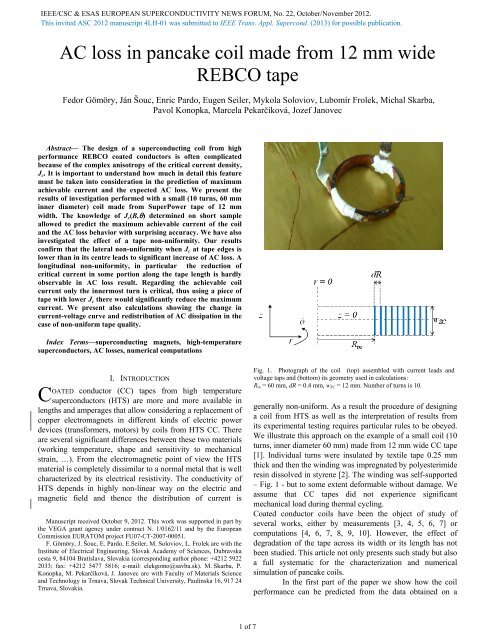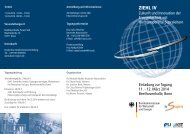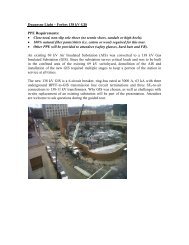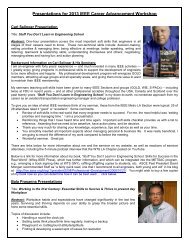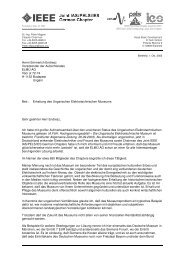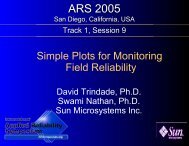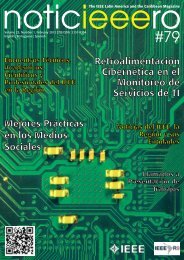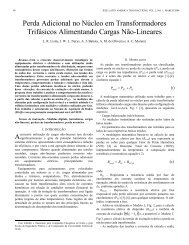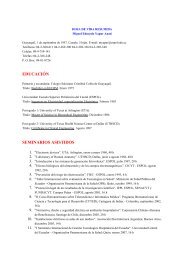AC loss in pancake coil made from 12 mm wide REBCO tape
AC loss in pancake coil made from 12 mm wide REBCO tape
AC loss in pancake coil made from 12 mm wide REBCO tape
Create successful ePaper yourself
Turn your PDF publications into a flip-book with our unique Google optimized e-Paper software.
IEEE/CSC & ESAS EUROPEAN SUPERCONDUCTIVITY NEWS FORUM, No. 22, October/November 20<strong>12</strong>.<br />
<strong>AC</strong> <strong>loss</strong> <strong>in</strong> <strong>pancake</strong> <strong>coil</strong> <strong>made</strong> <strong>from</strong> <strong>12</strong> <strong>mm</strong> <strong>wide</strong><br />
<strong>REBCO</strong> <strong>tape</strong><br />
Fedor Gömöry, Ján Šouc, Enric Pardo, Eugen Seiler, Mykola Soloviov, Lubomír Frolek, Michal Skarba,<br />
Pavol Konopka, Marcela Pekarčíková, Jozef Janovec<br />
Abstract— The design of a superconduct<strong>in</strong>g <strong>coil</strong> <strong>from</strong> high<br />
performance <strong>REBCO</strong> coated conductors is often complicated<br />
because of the complex anisotropy of the critical current density,<br />
Jc. It is important to understand how much <strong>in</strong> detail this feature<br />
must be taken <strong>in</strong>to consideration <strong>in</strong> the prediction of maximum<br />
achievable current and the expected <strong>AC</strong> <strong>loss</strong>. We present the<br />
results of <strong>in</strong>vestigation performed with a small (10 turns, 60 <strong>mm</strong><br />
<strong>in</strong>ner diameter) <strong>coil</strong> <strong>made</strong> <strong>from</strong> SuperPower <strong>tape</strong> of <strong>12</strong> <strong>mm</strong><br />
width. The knowledge of Jc(B,�) determ<strong>in</strong>ed on short sample<br />
allowed to predict the maximum achievable current of the <strong>coil</strong><br />
and the <strong>AC</strong> <strong>loss</strong> behavior with surpris<strong>in</strong>g accuracy. We have also<br />
<strong>in</strong>vestigated the effect of a <strong>tape</strong> non-uniformity. Our results<br />
confirm that the lateral non-uniformity when J c at <strong>tape</strong> edges is<br />
lower than <strong>in</strong> its centre leads to significant <strong>in</strong>crease of <strong>AC</strong> <strong>loss</strong>. A<br />
longitud<strong>in</strong>al non-uniformity, <strong>in</strong> particular the reduction of<br />
critical current <strong>in</strong> some portion along the <strong>tape</strong> length is hardly<br />
observable <strong>in</strong> <strong>AC</strong> <strong>loss</strong> result. Regard<strong>in</strong>g the achievable <strong>coil</strong><br />
current only the <strong>in</strong>nermost turn is critical, thus us<strong>in</strong>g a piece of<br />
<strong>tape</strong> with lower J c there would significantly reduce the maximum<br />
current. We present also calculations show<strong>in</strong>g the change <strong>in</strong><br />
current-voltage curve and redistribution of <strong>AC</strong> dissipation <strong>in</strong> the<br />
case of non-uniform <strong>tape</strong> quality.<br />
�<br />
Index Terms—superconduct<strong>in</strong>g magnets, high-temperature<br />
superconductors, <strong>AC</strong> <strong>loss</strong>es, numerical computations<br />
C<br />
I. INTRODUCTION<br />
OATED conductor (CC) <strong>tape</strong>s <strong>from</strong> high temperature<br />
superconductors (HTS) are more and more available <strong>in</strong><br />
lengths and amperages that allow consider<strong>in</strong>g a replacement of<br />
copper electromagnets <strong>in</strong> different k<strong>in</strong>ds of electric power<br />
devices (transformers, motors) by <strong>coil</strong>s <strong>from</strong> HTS CC. There<br />
are several significant differences between these two materials<br />
(work<strong>in</strong>g temperature, shape and sensitivity to mechanical<br />
stra<strong>in</strong>, …). From the electromagnetic po<strong>in</strong>t of view the HTS<br />
material is completely dissimilar to a normal metal that is well<br />
characterized by its electrical resistivity. The conductivity of<br />
HTS depends <strong>in</strong> highly non-l<strong>in</strong>ear way on the electric and<br />
magnetic field and thence the distribution of current is<br />
Manuscript received October 9, 20<strong>12</strong>. This work was supported <strong>in</strong> part by<br />
the VEGA grant agency under contract N. 1/0162/11 and by the European<br />
Co<strong>mm</strong>ission EURATOM project FU07-CT-2007-00051.<br />
F. Gömöry, J. Šouc, E. Pardo, E.Seiler, M. Soloviov, L. Frolek are with the<br />
Institute of Electrical Eng<strong>in</strong>eer<strong>in</strong>g, Slovak Academy of Sciences, Dubravska<br />
cesta 9, 84104 Bratislava, Slovakia (correspond<strong>in</strong>g author phone: +42<strong>12</strong> 5922<br />
2033; fax: +42<strong>12</strong> 5477 5816; e-mail: elekgomo@savba.sk). M. Skarba, P.<br />
Konopka, M. Pekarčíková, J. Janovec are with Faculty of Materials Science<br />
and Technology <strong>in</strong> Trnava, Slovak Technical University, Paulínska 16, 917 24<br />
Trnava, Slovakia.<br />
1 of 7<br />
Fig. 1. Photograph of the <strong>coil</strong> (top) assembled with current leads and<br />
voltage taps and (bottom) its geometry used <strong>in</strong> calculations:<br />
R<strong>in</strong> = 60 <strong>mm</strong>, dR = 0.4 <strong>mm</strong>, wSC = <strong>12</strong> <strong>mm</strong>. Number of turns is 10.<br />
generally non-uniform. As a result the procedure of design<strong>in</strong>g<br />
a <strong>coil</strong> <strong>from</strong> HTS as well as the <strong>in</strong>terpretation of results <strong>from</strong><br />
its experimental test<strong>in</strong>g requires particular rules to be obeyed.<br />
We illustrate this approach on the example of a small <strong>coil</strong> (10<br />
turns, <strong>in</strong>ner diameter 60 <strong>mm</strong>) <strong>made</strong> <strong>from</strong> <strong>12</strong> <strong>mm</strong> <strong>wide</strong> CC <strong>tape</strong><br />
[1]. Individual turns were <strong>in</strong>sulated by textile <strong>tape</strong> 0.25 <strong>mm</strong><br />
thick and then the w<strong>in</strong>d<strong>in</strong>g was impregnated by polyesterimide<br />
res<strong>in</strong> dissolved <strong>in</strong> styrene [2]. The w<strong>in</strong>d<strong>in</strong>g was self-supported<br />
– Fig. 1 - but to some extent deformable without damage. We<br />
assume that CC <strong>tape</strong>s did not experience significant<br />
mechanical load dur<strong>in</strong>g thermal cycl<strong>in</strong>g.<br />
Coated conductor <strong>coil</strong>s have been the object of study of<br />
several works, either by measurements [3, 4, 5, 6, 7] or<br />
computations [4, 6, 7, 8, 9, 10]. However, the effect of<br />
degradation of the <strong>tape</strong> across its width or its length has not<br />
been studied. This article not only presents such study but also<br />
a full systematic for the characterization and numerical<br />
simulation of <strong>pancake</strong> <strong>coil</strong>s.<br />
In the first part of the paper we show how the <strong>coil</strong><br />
performance can be predicted <strong>from</strong> the data obta<strong>in</strong>ed on a
IEEE/CSC & ESAS EUROPEAN SUPERCONDUCTIVITY NEWS FORUM, No. 22, October/November 20<strong>12</strong>.<br />
Fig. 2 Short-sample data (symbols) of the critical current dependence on the magnetic field magnitude (different symbol for each value expla<strong>in</strong>ed <strong>in</strong> the legend)<br />
and its orientation with respect to the CC <strong>tape</strong> <strong>wide</strong> face, def<strong>in</strong>ed by the angle � . Empirical fits with the expression (1) are shown by l<strong>in</strong>es. The measured<br />
dependence has explicit 360� periodicity at low magnetic fields, however beyond 100 mT the values for 90�-270� could be considered a repetition of those<br />
obta<strong>in</strong>ed <strong>in</strong> the -90� - 90� range.<br />
short sample. Because of highly non-l<strong>in</strong>ear properties of HTS<br />
<strong>tape</strong> it is necessary to employ numerical computation<br />
technique <strong>in</strong> the design of the <strong>coil</strong>. It is also useful <strong>in</strong> analysis<br />
of the observed behavior and allows to calculate the quantities<br />
that are not easily accessible <strong>in</strong> experimental way like the<br />
distribution of heat generated by <strong>AC</strong> current <strong>in</strong> the <strong>coil</strong>.<br />
II. TAPE PROPERTIES<br />
Basic <strong>in</strong>formation <strong>in</strong> the design of a superconduct<strong>in</strong>g <strong>coil</strong> is<br />
the dependence of critical current on magnetic field and its<br />
orientation. In the case of SuperPower <strong>tape</strong> SCS<strong>12</strong>050-AP this<br />
dependence is rather complicated as shows Fig. 2. Explanation<br />
of this complex dependence is beyond the scope of our<br />
<strong>in</strong>vestigation. However its description is essential <strong>in</strong> the <strong>coil</strong><br />
design and performance prediction. We have used several<br />
approximations [11], the results presented here have been<br />
obta<strong>in</strong>ed by us<strong>in</strong>g the empirical description:<br />
2<br />
� ��<br />
��<br />
� �<br />
0(<br />
B)<br />
� I 2(<br />
B)<br />
�1<br />
� � � �<br />
� �1�<br />
�<br />
� � ��<br />
� � I1(<br />
B)<br />
�<br />
I1(<br />
B)<br />
�<br />
J c ( B,<br />
� ) � � �<br />
for � ��<br />
0 � �<br />
SSC<br />
�<br />
�<br />
��<br />
1 for � ��<br />
0 � ��<br />
where �� = 0.75 radians and<br />
(1)<br />
�<br />
2 of 7<br />
I ( B)<br />
� I<br />
1<br />
I ( B)<br />
� I<br />
2<br />
m<strong>in</strong> 0<br />
max 0<br />
�<br />
�1�<br />
k<br />
��<br />
�<br />
�1�<br />
k<br />
��<br />
m<strong>in</strong><br />
max<br />
� �<br />
� �<br />
�<br />
�<br />
0 ( B)<br />
� �00<br />
1�<br />
k�<br />
1�<br />
��<br />
�<br />
�<br />
�<br />
�1�<br />
�<br />
�<br />
�<br />
�1�<br />
�<br />
B<br />
B<br />
0<br />
�<br />
�<br />
�<br />
�<br />
with the parameters B0 = 0.5 T, � = 4.5, Im<strong>in</strong>0 = 136 A, Imax0 =<br />
218 A, �00 = 0.58 radians and SSC is the cross-section of the<br />
Critical current [A]<br />
400<br />
380<br />
360<br />
340<br />
320<br />
300<br />
280<br />
260<br />
240<br />
220<br />
200<br />
B<br />
B<br />
0<br />
B<br />
B<br />
�<br />
�<br />
�<br />
�<br />
�<br />
0<br />
�<br />
�<br />
��<br />
�<br />
�<br />
�<br />
�<br />
�<br />
1 2 3 4 5 6 7 8 9 10<br />
Turn number<br />
Fig. 3. Critical currents of <strong>coil</strong> turns estimated with the help of (1). Turns are<br />
numbered <strong>from</strong> <strong>in</strong>side towards outside, the <strong>in</strong>nermost turn has number 1.<br />
�<br />
�<br />
��<br />
�<br />
�<br />
�<br />
��
IEEE/CSC & ESAS EUROPEAN SUPERCONDUCTIVITY NEWS FORUM, No. 22, October/November 20<strong>12</strong>.<br />
0.001<br />
E <strong>coil</strong><br />
[V<br />
]<br />
/m<br />
0.0001<br />
Experiment<br />
Simulation<br />
Simulation - 2% degradation all turns<br />
Simulation - 7% degradation turn 1<br />
Simulation - 7% degradation all turns<br />
0.00001<br />
200 I<strong>coil</strong> [A]<br />
300<br />
Fig. 4. Current-voltage dependence calculated for the <strong>coil</strong> (full l<strong>in</strong>e)<br />
compared with the experimental data (circles). Better agreement is reached<br />
assum<strong>in</strong>g the critical current data lowered by 2% (dotted). Simulations for a<br />
7% degradation of the <strong>in</strong>nermost turn (long dashes) and of all the <strong>coil</strong> turns<br />
(short dashes) were carried out to see how much such damage could be<br />
detected <strong>in</strong> the E(I) tests.<br />
superconduct<strong>in</strong>g layer that <strong>in</strong> our calculations was represented<br />
by the rectangle of width wSC = <strong>12</strong> <strong>mm</strong> and thickness hSC =<br />
1 �m. The expression (1) with these parameters fits the data<br />
for angles � <strong>from</strong> -90� to 90�and magnetic fields higher than<br />
0.1 T, the critical currents for lower fields are slightly higher<br />
<strong>in</strong> the range of angles � between 90� and 270�.<br />
III. MAXIMUM DC CURRENT OF THE COIL<br />
Knowledge of the <strong>tape</strong> critical current described by the<br />
expression (1) allows to predict the maximal DC current the<br />
<strong>coil</strong> could carry. For this purpose we created the f<strong>in</strong>ite-element<br />
model based on the geometry shown <strong>in</strong> Fig. 1. Rotational<br />
sy<strong>mm</strong>etry is used i.e. the real spiral turns have been replaced<br />
by circular ones. The approximation of uniform current<br />
density <strong>in</strong> the w<strong>in</strong>d<strong>in</strong>g was used to calculate the magnetic field<br />
distribution <strong>in</strong> the <strong>coil</strong>. Then <strong>in</strong> an iterative procedure the level<br />
of <strong>coil</strong> current that would generate the electrical field Ec =<br />
1 μV/cm <strong>in</strong> various turns has been identified. The result – that<br />
could be with certa<strong>in</strong> simplification called the critical currents<br />
of <strong>in</strong>dividual turns – is shown <strong>in</strong> Fig. 3. As expected, the<br />
<strong>in</strong>nermost turn (assigned No. 1) limits the maximum DC<br />
current the <strong>coil</strong> could carry. Then it does not make much sense<br />
to calculate the current that would create 1 μV/cm electrical<br />
field <strong>in</strong> the whole <strong>coil</strong>. Instead we estimated the currentvoltage<br />
curve of the whole <strong>coil</strong>. A rigorous calculation would<br />
require <strong>in</strong> the f<strong>in</strong>ite element calculation a dense mesh of<br />
current-voltage dependences taken on short sample at different<br />
field values and orientations. We used a simplified procedure<br />
<strong>in</strong>stead: First, the measured short sample curves were<br />
approximated by the power-law function � �n E ( I ) � E c I I c<br />
(<strong>from</strong> which the values of Ic found at Ec = 1 μV/cm were used<br />
<strong>in</strong> Fig. 2) where the exponent n was found to vary between 17<br />
and 25 <strong>in</strong> the range of magnetic fields 0.08-0.14 T that would<br />
appear <strong>in</strong> the <strong>coil</strong> w<strong>in</strong>d<strong>in</strong>g at carry<strong>in</strong>g maximum current. Then<br />
we took the “critical currents” of <strong>in</strong>dividual turns, Ici, and the<br />
power-law exponent <strong>in</strong> the mid of its range, n = 21 to estimate<br />
the current-voltage curve of the <strong>coil</strong>:<br />
E<br />
<strong>coil</strong><br />
( I<br />
<strong>coil</strong><br />
)<br />
N<br />
�<br />
�<br />
i�1<br />
i<br />
N<br />
� I<br />
2�r<br />
E<br />
�<br />
� c<br />
� I<br />
�<br />
i�1<br />
2�r<br />
i<br />
In this expression N = 10 is the number of turns, each of them<br />
at the radius ri. The result was confronted with experimental<br />
data as shown <strong>in</strong> Fig. 4. Calculated prediction is slightly<br />
higher than the experimental f<strong>in</strong>d<strong>in</strong>g. Key role of the<br />
<strong>in</strong>nermost turn is illustrated by E(I) curve calculated<br />
consider<strong>in</strong>g the degradation of critical current by e.g. 7%: The<br />
shift towards lower currents obta<strong>in</strong>ed for a uniform reduction<br />
of Ici <strong>in</strong> all the turns is close to the result obta<strong>in</strong>ed assum<strong>in</strong>g<br />
such degradation <strong>in</strong> the <strong>in</strong>nermost turn alone.<br />
IV. <strong>AC</strong> LOSS BEHAVIOR<br />
In the case of a <strong>coil</strong> considered for power application the<br />
dissipation at <strong>AC</strong> transport (<strong>AC</strong> <strong>loss</strong>) is an important<br />
parameter. We performed numerical calculations based on the<br />
A-�-j formulation of critical state utiliz<strong>in</strong>g the f<strong>in</strong>ite-element<br />
code Comsol Multiphysics [<strong>12</strong>]. The orig<strong>in</strong>al stepwise currentvoltage<br />
curve proposed for hard superconductor [13] is<br />
replaced by its smooth approximation<br />
J<br />
3 of 7<br />
s,<br />
�<br />
( r,<br />
z)<br />
� J<br />
c<br />
<strong>coil</strong><br />
ci<br />
�<br />
�<br />
�<br />
�<br />
n<br />
(2)<br />
� E�<br />
( r,<br />
z)<br />
�<br />
tanh<br />
�<br />
�<br />
�<br />
� . (3)<br />
� Ec<br />
�<br />
where the critical current density Jc is now the upper limit for<br />
the current density <strong>in</strong> superconductor, Js, and the cyl<strong>in</strong>drical<br />
geometry shown <strong>in</strong> Fig.1 was <strong>in</strong>troduced. Because the<br />
electrical field is generated by the electrostatic gradient � �<br />
as well as the time variation of the magnetic vector potential,<br />
A � , the expression (3) can be rewritten [6] as<br />
�<br />
�A�<br />
( r,<br />
z)<br />
�<br />
� � ��<br />
( r,<br />
z)<br />
� �<br />
�<br />
�<br />
�t<br />
� (4)<br />
J s,<br />
� ( r,<br />
z)<br />
J c ( B,<br />
� ) tanh<br />
� Ec<br />
�<br />
�<br />
�<br />
�<br />
�<br />
.<br />
where we also <strong>in</strong>dicated that Jc depends on the local value of<br />
magnetic field and its orientation with respect to the <strong>tape</strong>. In<br />
the f<strong>in</strong>ite element calculation the distribution of A and �� is<br />
found that obeys the Maxwell equations with the additional<br />
constra<strong>in</strong>t that the total current <strong>in</strong> each turn is equal to the<br />
current delivered by the power supply
�<br />
S<br />
IEEE/CSC & ESAS EUROPEAN SUPERCONDUCTIVITY NEWS FORUM, No. 22, October/November 20<strong>12</strong>.<br />
i<br />
J<br />
s,<br />
�<br />
( r,<br />
z)<br />
i �1..<br />
N<br />
� I<br />
<strong>coil</strong><br />
Series of distributions are calculated for<br />
I � I �t ) � I s<strong>in</strong>( � )<br />
(6)<br />
<strong>coil</strong> , j max s<strong>in</strong>( j max j<br />
where � is the angle frequency and �j = 0, �.�tj, 2�.�tj,,… 2�<br />
are the angles correspond<strong>in</strong>g to the time <strong>in</strong>stants tj when the<br />
distributions are resolved. We have found that calculation of<br />
M = 40 distributions <strong>in</strong> one <strong>AC</strong> period is sufficient to obta<strong>in</strong><br />
the representative result with<strong>in</strong> reasonable computation time.<br />
The power dissipated <strong>in</strong> the <strong>coil</strong> at the time <strong>in</strong>stant tj is the<br />
sum of contributions <strong>from</strong> <strong>in</strong>dividual turns<br />
P<br />
j<br />
� N<br />
� �<br />
i�1 S<br />
i<br />
J ( r,<br />
z)<br />
E ( r,<br />
z)<br />
dS<br />
(7)<br />
s<br />
i,<br />
j<br />
where Js is calculated us<strong>in</strong>g (4) and the electrical field <strong>in</strong> the ith<br />
turn at the <strong>in</strong>stant def<strong>in</strong>ed by �j is<br />
E<br />
Q [J/m]<br />
i,<br />
j<br />
1.E‐01<br />
1.E‐02<br />
1.E‐03<br />
1.E‐04<br />
1.E‐05<br />
10 100 Imax [A]<br />
100<br />
( r,<br />
z)<br />
� �� �<br />
i,<br />
j<br />
A ( r,<br />
z)<br />
� A ( r,<br />
z)<br />
� �<br />
� � �<br />
� j � j �1<br />
(8)<br />
j<br />
j �1<br />
Experiment<br />
Jc(B)<br />
Jc(B) + Nonuniformity<br />
Fig. 5. <strong>AC</strong> <strong>loss</strong> <strong>in</strong> the <strong>coil</strong> calculated by f<strong>in</strong>ite-element method (l<strong>in</strong>es)<br />
compared with experimental data (symbols). Tak<strong>in</strong>g <strong>in</strong>to account the Jc(B,�)<br />
is not enough to reproduce the measurements (dashed l<strong>in</strong>e). Sufficient<br />
agreement was obta<strong>in</strong>ed when the lateral non-uniformity <strong>in</strong> the critical<br />
current density was considered (full l<strong>in</strong>e).<br />
In the last expression we took <strong>in</strong>to account that �� is constant<br />
<strong>in</strong> the cross-section of one turn and it thus atta<strong>in</strong>s discrete<br />
values��i for different turns [14, 15]. The power dissipated <strong>in</strong><br />
all the turns is <strong>in</strong>tegrated over one cycle to obta<strong>in</strong> the total <strong>loss</strong><br />
<strong>in</strong> the w<strong>in</strong>d<strong>in</strong>g. In order to allow comparison with results<br />
obta<strong>in</strong>ed on different <strong>coil</strong>s we prefer to present the dissipation<br />
(5)<br />
4 of 7<br />
J c [A/m 2 ]<br />
divided by the total length of the <strong>tape</strong> <strong>in</strong> Joule/meter units:<br />
Q<br />
2.3<br />
2.1<br />
1.9<br />
1.7<br />
1.5<br />
1.3<br />
1.1<br />
0.9<br />
0.7<br />
x 1e10<br />
0.5<br />
‐6 ‐4 ‐2 0 2 4 6<br />
position with respect to the <strong>tape</strong> centre [<strong>mm</strong>]<br />
Fig. 6. Nonuniformity of the <strong>tape</strong> across its width illustrated by (top) profile<br />
of the critical current density and (bottom) morphology of the<br />
superconduct<strong>in</strong>g layer. The profile of Jc (full l<strong>in</strong>e) was obta<strong>in</strong>ed <strong>from</strong> the<br />
measured distribution of magnetic field above the <strong>tape</strong> carry<strong>in</strong>g critical<br />
current at DC background field of 250 mT. Its l<strong>in</strong>ear approximation is shown<br />
by the dashed l<strong>in</strong>e. Electron microscope pictures were taken after remow<strong>in</strong>g<br />
the protect<strong>in</strong>g Ag and stabiliz<strong>in</strong>g Cu layer. The <strong>in</strong>homogenities – seen as<br />
“islands” <strong>in</strong> the superconduct<strong>in</strong>g layer - occupy bigger portion at <strong>tape</strong> edges.<br />
2�<br />
M<br />
M<br />
� Pj<br />
�t<br />
� Pj<br />
j �1<br />
�M<br />
j �1<br />
� � N<br />
L<strong>coil</strong><br />
� 2�ri<br />
i �1<br />
The prediction obta<strong>in</strong>ed by such calculation <strong>in</strong>corporat<strong>in</strong>g<br />
the Jc(B,�) expression (1) is compared <strong>in</strong> Fig. 5 with<br />
experimental data determ<strong>in</strong>ed by standard lock-<strong>in</strong> technique.<br />
The <strong>loss</strong> per cycle measured at frequencies of 36, 72 and 144<br />
Hz, respectively, was identical testify<strong>in</strong>g pure hysteretic<br />
character consistent with the critical state model. As one can<br />
see, the calculated prediction (dashed l<strong>in</strong>e) was below the<br />
experimental data. The observed discrepancy was removed<br />
when we took <strong>in</strong>to account the fact that the <strong>tape</strong> edges exhibit<br />
(9)
IEEE/CSC & ESAS EUROPEAN SUPERCONDUCTIVITY NEWS FORUM, No. 22, October/November 20<strong>12</strong>.<br />
Q [J/m]<br />
1.E‐01<br />
1.E‐02<br />
1.E‐03<br />
1.E‐04<br />
Experiment<br />
Calculation, Ic = 260 A<br />
Calculation, Ic = 334 A<br />
Calculation, Ic = 390 A<br />
1.E‐05<br />
10 100 Imax [A]<br />
1000<br />
Fig. 7. <strong>AC</strong> <strong>loss</strong> <strong>in</strong> the <strong>coil</strong> calculated <strong>in</strong> simplified manner assum<strong>in</strong>g a<br />
constant critical current density, Jc, (l<strong>in</strong>es) compared with experimental data<br />
(symbols). The results are shown for three values of Jc correspond<strong>in</strong>g to the<br />
<strong>tape</strong> critical currents shown <strong>in</strong> the legend.<br />
reduced current transport capability compared to the central<br />
part. Such reduction was observed <strong>in</strong> separate experiment<br />
mapp<strong>in</strong>g the magnetic field distribution above the <strong>tape</strong><br />
transport<strong>in</strong>g DC current. The variation of Jc across the <strong>tape</strong><br />
width shown <strong>in</strong> Fig. 6 has been derived by an <strong>in</strong>version<br />
calculation [16]. Also the structural <strong>in</strong>vestigations we<br />
performed by scann<strong>in</strong>g electron microscopy revealed that<br />
there is significant difference <strong>in</strong> the superconduct<strong>in</strong>g layer<br />
morphology across the <strong>tape</strong> width. The structural analysis<br />
suggests that the volume ratio of <strong>in</strong>homogeneities <strong>in</strong> the<br />
superconduct<strong>in</strong>g layer is <strong>in</strong>creased towards both edges of the<br />
<strong>tape</strong>. Such non-uniformity can never be deduced <strong>from</strong> the<br />
Ic(B,�) data. On the other hand at <strong>AC</strong> transport the dissipation<br />
depends on details of the flux front movement result<strong>in</strong>g <strong>in</strong><br />
significant difference between two calculated curves <strong>in</strong> Fig. 5.<br />
However, the co<strong>in</strong>cidence of the measured <strong>AC</strong> <strong>loss</strong><br />
data with the calculation is not always the proof of a valid<br />
description of superconductor properties. We performed a<br />
series of <strong>AC</strong> <strong>loss</strong> calculations neglect<strong>in</strong>g the magnetic-field<br />
dependence of the critical current density. Ma<strong>in</strong> motivation for<br />
such exercise was to check how much the improvement (or<br />
degradation) of the critical current would affect the <strong>AC</strong> <strong>loss</strong>.<br />
Here we show the results for three values of Jc that for the<br />
considered cross-section of superconduct<strong>in</strong>g layer (<strong>12</strong> <strong>mm</strong><br />
<strong>wide</strong> and 1 µm thick) correspond to the critical currents equal<br />
to 260, 334 and 390 A, respectively. The lowest and highest of<br />
these values are the extreme levels of critical currents that<br />
were calculated for <strong>in</strong>dividual turns <strong>in</strong> the <strong>coil</strong> tak<strong>in</strong>g the<br />
complex Ic(B,�) of the <strong>tape</strong> <strong>in</strong>to account. The middle value is<br />
obta<strong>in</strong>ed <strong>from</strong> an average of these values shown <strong>in</strong> Fig. 2.<br />
The ma<strong>in</strong> conclusion is that the <strong>coil</strong> <strong>loss</strong> calculated<br />
assum<strong>in</strong>g a field-<strong>in</strong>dependent critical current density Jc =<br />
const. – see Fig. 7 - is <strong>in</strong>versely proportional to Jc. Such<br />
behavior is typical for the self-field (transport) regime [17].<br />
Maybe <strong>in</strong> a <strong>coil</strong> with significantly larger number of turns this<br />
5 of 7<br />
conclusion could not apply. Rather surpris<strong>in</strong>g however is that<br />
the result calculated <strong>in</strong> such simplified manner - assum<strong>in</strong>g that<br />
the critical current density <strong>in</strong> all the w<strong>in</strong>d<strong>in</strong>g is equal to that of<br />
the <strong>in</strong>nermost turn - does very well match the experimental<br />
data. We believe this is a mere co<strong>in</strong>cidence: As shown by the<br />
dashed l<strong>in</strong>e <strong>in</strong> Fig. 5 the slope of the <strong>loss</strong> curve obta<strong>in</strong>ed<br />
assum<strong>in</strong>g Jc(B) dependence - without lateral non-uniformity -<br />
would be higher than that one result<strong>in</strong>g <strong>from</strong> a Jc = const.<br />
assumption.<br />
As we have found, the lateral non-uniformity of Jc<br />
with respect to the <strong>tape</strong> width has significant <strong>in</strong>fluence on the<br />
<strong>coil</strong> <strong>loss</strong>. This effect has already been found <strong>in</strong> the case of<br />
power transmission cable [18] or fault current limiter [19]. In<br />
the follow<strong>in</strong>g we present the results of our analysis about the<br />
possible consequence of Jc variation along the <strong>tape</strong> length. In<br />
particular we calculated the <strong>AC</strong> <strong>loss</strong> and its distribution <strong>in</strong> the<br />
w<strong>in</strong>d<strong>in</strong>g <strong>in</strong> the case when Jc <strong>in</strong> one of the turns is lower than <strong>in</strong><br />
the rest.<br />
V. INFLUENCE OF LOCAL I C DEGRADATION<br />
In this section we show the results of <strong>AC</strong> <strong>loss</strong> calculation<br />
performed follow<strong>in</strong>g the procedure described by the formulas<br />
(4) to (9) i.e. tak<strong>in</strong>g <strong>in</strong>to account the complex Jc(B,�)<br />
established on the short sample assum<strong>in</strong>g however that the<br />
superconductor <strong>in</strong> some turns has Jc that is proportionally<br />
lowered at all the field magnitudes and orientations.<br />
First notable feature is that the <strong>AC</strong> <strong>loss</strong> is far less sensitive to a<br />
s<strong>in</strong>gle turn degradation than the current-voltage curve. This is<br />
obvious when compar<strong>in</strong>g the effect of reduc<strong>in</strong>g the critical<br />
current of the <strong>in</strong>nermost turn to 93% of orig<strong>in</strong>al value on the<br />
current-voltage curve <strong>in</strong> Fig. 4 with the <strong>AC</strong> <strong>loss</strong> result shown<br />
<strong>in</strong> Fig. 8. Even a drop to 75% of the orig<strong>in</strong>al value does not<br />
produce an <strong>in</strong>crease of <strong>AC</strong> <strong>loss</strong> <strong>in</strong> the <strong>coil</strong> that would be<br />
dist<strong>in</strong>ctively beyond the experimental noise.<br />
1.E‐04<br />
Q [J/m]<br />
1.E‐05<br />
10<br />
No degradation<br />
7% degradation of turn 1<br />
25% degradation of turn 1<br />
I max [A]<br />
Fig. 8. Calculated effect of a reduced critical current <strong>in</strong> the <strong>in</strong>nermost turn on<br />
<strong>AC</strong> <strong>loss</strong>: <strong>loss</strong> <strong>in</strong> the <strong>coil</strong> (full l<strong>in</strong>e <strong>from</strong> Fig. 5) compared with the result<br />
obta<strong>in</strong>ed assum<strong>in</strong>g critical current of the turn N.1 reduced to 93% and 75%,<br />
respectively. As one can see, such degradation produces an effect that is<br />
hardly visible.<br />
50
IEEE/CSC & ESAS EUROPEAN SUPERCONDUCTIVITY NEWS FORUM, No. 22, October/November 20<strong>12</strong>.<br />
Loss per cycle [J]<br />
2.E‐04<br />
1.E‐04<br />
0.E+00<br />
1 2 3 4 5 6 7 8 9 10<br />
Turn number, i<br />
This result can be better understood when we analyze<br />
the distribution of dissipation <strong>in</strong> the <strong>coil</strong> w<strong>in</strong>d<strong>in</strong>g. In Fig. 9 the<br />
dissipation is plotted as calculated for <strong>in</strong>dividual turns <strong>in</strong> the<br />
<strong>AC</strong> cycle with amplitude of 70 A. The dissipation is rather<br />
uniformly distributed <strong>in</strong>side the <strong>coil</strong>, the extreme turns (the<br />
<strong>in</strong>nermost and the outermost ones) produc<strong>in</strong>g heat about 50%<br />
above the average. Then one can better understand why a<br />
reduction of the critical current <strong>in</strong> one turn causes a m<strong>in</strong>or<br />
<strong>in</strong>crease of the dissipation <strong>in</strong> the whole <strong>coil</strong>. It is <strong>in</strong>terest<strong>in</strong>g is<br />
that an <strong>in</strong>crease of dissipation is predicted also for the<br />
neighbor<strong>in</strong>g turns <strong>in</strong> spite of the fact that their properties have<br />
not changed. Surpris<strong>in</strong>g is the result we have found for higher<br />
<strong>AC</strong> amplitudes as shown <strong>in</strong> Fig. 10: In the case of <strong>coil</strong> <strong>made</strong><br />
of <strong>tape</strong> with the same properties <strong>in</strong> all the turns the dissipation<br />
pattern is similar to that found at lower currents. Strik<strong>in</strong>g is the<br />
prediction that us<strong>in</strong>g a degraded <strong>tape</strong> <strong>in</strong> the <strong>in</strong>nermost turn<br />
would reduce the dissipation <strong>in</strong> that turn at higher currents.<br />
The elevated <strong>AC</strong> <strong>loss</strong> <strong>in</strong> the whole <strong>coil</strong> should be borne by<br />
nearly all the rema<strong>in</strong><strong>in</strong>g turns, the additional dissipation<br />
peak<strong>in</strong>g at the neighbor<strong>in</strong>g turn N.2. We have checked this<br />
prediction also by a different numerical method based on the<br />
critical state pr<strong>in</strong>ciples [10] with identical results.<br />
Unfortunately there is no easy way to detect the local<br />
dissipation <strong>in</strong> <strong>coil</strong> turns <strong>in</strong> experiment.<br />
VI. CONCLUSION<br />
Undegraded Ic<br />
75% Ic <strong>in</strong> Turn 1<br />
Fig. 9. Distribution of dissipation <strong>in</strong> the <strong>coil</strong> turns at <strong>AC</strong> amplitude of 70 A<br />
(27% of undegraded Ic of <strong>in</strong>ner turn): L<strong>in</strong>e with diamonds shows the values<br />
calculated for the <strong>coil</strong> <strong>made</strong> of identical turns <strong>from</strong> the <strong>tape</strong> with properties<br />
shown <strong>in</strong> Fig.2. The full squares have been obta<strong>in</strong>ed assum<strong>in</strong>g that <strong>in</strong> the<br />
<strong>in</strong>nermost turn the critical current has been lowered by 25%.<br />
Properties of a small <strong>coil</strong> <strong>made</strong> <strong>from</strong> <strong>12</strong> <strong>mm</strong> <strong>wide</strong> CC <strong>tape</strong><br />
have been <strong>in</strong>vestigated experimentally and by f<strong>in</strong>ite element<br />
numerical models. Tak<strong>in</strong>g <strong>in</strong>to account the complexity of Jc<br />
dependence on magnetic field and its orientation <strong>in</strong> the<br />
calculation we achieved rather precise prediction of the DC<br />
current-voltage curve of the <strong>coil</strong> as well as the dissipation <strong>in</strong><br />
<strong>AC</strong> regime.<br />
6 of 7<br />
Loss per cycle [J]<br />
1.5E‐03<br />
1.0E‐03<br />
5.0E‐04<br />
Undegraded Ic<br />
75% Ic <strong>in</strong> Turn 1<br />
1 2 3 4 5 6 7 8 9 10<br />
Turn number, i<br />
Fig. 10. The same as Fig. 9 but the <strong>AC</strong> amplitude is now 140 A (54% of<br />
undegraded Ic of <strong>in</strong>ner turn). Surpris<strong>in</strong>g is that the turn with lowered critical<br />
current exhibits lower dissipation than <strong>in</strong> the case it were undegraded. The<br />
<strong>in</strong>creased dissipation is distributed <strong>in</strong> the rema<strong>in</strong><strong>in</strong>g <strong>coil</strong> turns.<br />
Similar to the results of other groups analyz<strong>in</strong>g the <strong>AC</strong> <strong>loss</strong><br />
<strong>in</strong> superconduct<strong>in</strong>g cables or fault current limiters we have<br />
found that a non-uniform transport capability of the HTS<br />
material across the <strong>tape</strong> width leads to significant <strong>in</strong>crease <strong>in</strong><br />
<strong>AC</strong> dissipation. Our structural <strong>in</strong>vestigations provide strong<br />
<strong>in</strong>dication that this phenomenon is caused by <strong>in</strong>creased share<br />
of “islands” not participat<strong>in</strong>g <strong>in</strong> the current flow at the <strong>tape</strong><br />
edges.<br />
Longitud<strong>in</strong>al non-uniformity of <strong>tape</strong> critical current can<br />
have severe consequences on the maximum current it is able<br />
to reach. On the other hand the <strong>AC</strong> <strong>loss</strong> is rather <strong>in</strong>sensitive to<br />
this matter. This could maybe expla<strong>in</strong> surpris<strong>in</strong>g similarity of<br />
<strong>AC</strong> <strong>loss</strong> of <strong>coil</strong>s with rather different critical current [20]. Our<br />
calculations confirmed that for a <strong>coil</strong> with constant Jc the <strong>AC</strong><br />
<strong>loss</strong> would be <strong>in</strong>versely proportional to Jc.<br />
Rather <strong>in</strong>terest<strong>in</strong>g is the result of numerical calculation<br />
show<strong>in</strong>g that a turn <strong>from</strong> <strong>tape</strong> with reduced Jc could transfer<br />
the surplus dissipation to neighbor<strong>in</strong>g turns. At <strong>AC</strong> currents<br />
with amplitude approach<strong>in</strong>g the critical current this would<br />
even make the actual dissipation <strong>in</strong> weaker turn lower<br />
compared to the case when all the turns are <strong>made</strong> <strong>from</strong><br />
identical <strong>tape</strong>. Experimental verification of this theoretical<br />
prediction would be very desirable.<br />
REFERENCES<br />
[1] www.superpower-<strong>in</strong>c.com<br />
[2] L. Frolek, E. Seiler, J. Šouc, E. Pardo, “Properties of impregnated<br />
superconduct<strong>in</strong>g <strong>coil</strong>s <strong>made</strong> form YBCO coated conductor us<strong>in</strong>g<br />
different technology of impregnation,” Proceed<strong>in</strong>gs of the <strong>12</strong>th<br />
Cryogenic 20<strong>12</strong> IIR Conference, Dresden, Germany, September 11-14,<br />
pp. 333 -337, 20<strong>12</strong><br />
[3] M. Polak, E. Demencik, L. Jansak, P. Mozola, D. Aized, C. L. H.<br />
Thieme, G. A. Lev<strong>in</strong>, and P. N. Barnes, “ac <strong>loss</strong>es <strong>in</strong> a YBa2Cu3O7−x<br />
<strong>coil</strong>”, Applied physics letters, 88, no. 23, pp. 232 501–232 501, 2006.
IEEE/CSC & ESAS EUROPEAN SUPERCONDUCTIVITY NEWS FORUM, No. 22, October/November 20<strong>12</strong>.<br />
[4] F. Grilli and S. P. Ashworth, “Measur<strong>in</strong>g transport ac <strong>loss</strong>es <strong>in</strong> YBCOcoated<br />
conductor <strong>coil</strong>s”, Superconductor Science and Technology 20, p.<br />
794, 2007.<br />
[5] E. Pardo, J. Šouc, M. Vojenčiak, and F. Gömöry, “<strong>AC</strong> <strong>loss</strong> and voltage<br />
signal <strong>in</strong> a <strong>pancake</strong> <strong>coil</strong> <strong>made</strong> of coated conductor with ferromagnetic<br />
substrate,” IEEE Transactions on Applied Superconductivity 19, no. 3, p.<br />
2223, 2009.<br />
[6] E. Pardo, J. Šouc, and J. Kováč, “<strong>AC</strong> <strong>loss</strong> <strong>in</strong> ReBCO <strong>pancake</strong> <strong>coil</strong>s and<br />
stacks of them: modell<strong>in</strong>g and measurement”, Superconductor Science<br />
and Technology 25, p. 035003, 20<strong>12</strong>.<br />
[7] W. Yuan, T. Coombs, J. Kim, C. Han Kim, J. Kvitkovic, and S. Pamidi,<br />
“Measurements and calculations of transport ac <strong>loss</strong> <strong>in</strong> second genera-<br />
tion high temperature superconduct<strong>in</strong>g <strong>pancake</strong> <strong>coil</strong>s”, Journal of<br />
Applied Physics 110, no. 11, pp. 113 906–113 906, 2011.<br />
[8] J. Clem, J. Claassen, and Y. Mawatari, “<strong>AC</strong> <strong>loss</strong>es <strong>in</strong> a f<strong>in</strong>ite Z stack<br />
us<strong>in</strong>g an anisotropic homogeneous-medium approximation”,<br />
Superconductor Science and Technology, 20, p. 1130, 2007.<br />
[9] M. A<strong>in</strong>slie, V. Rodriguez-Zermeno, Z. Hong, W. Yuan, T. Flack, and T.<br />
Coombs, “An improved FEM model for comput<strong>in</strong>g transport <strong>AC</strong> <strong>loss</strong> <strong>in</strong><br />
<strong>coil</strong>s <strong>made</strong> of RABiTS YBCO coated conductors for electric mach<strong>in</strong>es”,<br />
Superconductor Science and Technology 24, p. 045005, 2011.<br />
[10] E. Pardo, “Model<strong>in</strong>g of coated conductor <strong>pancake</strong> <strong>coil</strong>s with a large<br />
number of turns,” Supercond. Sci Technol. 21, art. nr.065014, 2008.<br />
[11] E. Pardo, M. Vojenčiak, F. Gömöry, J. Šouc, “Low-magnetic-field<br />
dependence and anisotropy of the critical current density <strong>in</strong> coated<br />
conductors, “ Supercond. Sci Technol. 24, art. nr. 065007(2011)<br />
[<strong>12</strong>] F. Gömöry, M. Vojenčiak, E. Pardo, M. Solovyov, J. Šouc, “ <strong>AC</strong> <strong>loss</strong>es<br />
<strong>in</strong> coated conductors,” Supercond. Sci Technol. 23, art.nr. 0340<strong>12</strong>,<br />
March 2010<br />
[13] C. P. Bean, “Magnetization of hard superconductors,” Phys. Rev.<br />
Letters 8, pp. 250-253, March 1962.<br />
[14] E. Pardo, F. Gömöry, J. Šouc, J. M. Ceballos, “Current distribution and<br />
ac <strong>loss</strong> for a superconduct<strong>in</strong>g rectangular strip with <strong>in</strong>-phase alternat<strong>in</strong>g<br />
current and applied field,” Supercond. Sci Technol. 20, no. 4, pp. 351–<br />
364, 2007.<br />
[15] W. J. Carr Jr. “On the theory of the electric field and current density <strong>in</strong> a<br />
superconductor carry<strong>in</strong>g transport current,” Physica C 425 pp155-165,<br />
September 2005<br />
[16] M. Solovyov, J. Šouc, F. Gömöry, “ Investigation of superconductor<br />
uniformity <strong>in</strong> CC <strong>tape</strong>s by magnetic field mapp<strong>in</strong>g,” Physics Procedia<br />
36, pp. 617-622, 20<strong>12</strong><br />
[17] W. T. Norris, “Calculation of hysteresis <strong>loss</strong>es <strong>in</strong> hard superconductors<br />
carry<strong>in</strong>g ac: isolated conductors and edges of th<strong>in</strong> sheets,” J. Phys. D 3,<br />
pp. 489-507, April 1970.<br />
[18] N. Amemiya, Z. Jiang, Z. Li, M. Nakahata, T. Kato, M. Ueyama, N.<br />
Kashima, S. Nagaya, S. Shiohara, “Transport <strong>loss</strong>es <strong>in</strong> s<strong>in</strong>gle and<br />
assembled coated conductors with textured-metal substrate with reduced<br />
magnetism”, Physica C 468, pp.1718–1722, June 2008<br />
[19] D. N. Nguyen, F. Grilli, S. P. Ashworth and J. O Willis, “<strong>AC</strong> <strong>loss</strong> study<br />
of antiparallel connected YBCO coated conductors,” Supercond. Sci<br />
Technol. 22, art.nr. 055014, April 2009<br />
[20] Sastry Pamidi “Total <strong>AC</strong> Loss Measurement on 2G Superconduct<strong>in</strong>g<br />
Coils”, Paper S-I-1042 presented at 3 rd International Conference on<br />
Superconductivity and Magnetism, 29 April-4 May 20<strong>12</strong>, Istanbul,<br />
Turkey<br />
7 of 7


